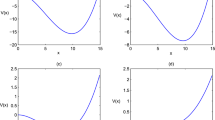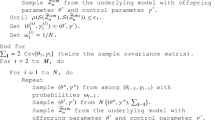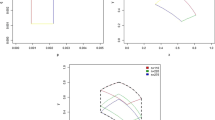Abstract
We provide a Galton–Watson model for the growth of a bacterial population in the presence of antibiotics. We assume that bacterial cells either die or duplicate, and the corresponding probabilities depend on the concentration of the antibiotic. Assuming that the mean offspring number is given by \(m(c) = 2 / (1 + \alpha c^\beta )\) for some \(\alpha , \beta \), where c stands for the antibiotic concentration we obtain weakly consistent, asymptotically normal estimator both for \((\alpha , \beta )\) and for the minimal inhibitory concentration, a relevant parameter in pharmacology. We apply our method to real data, where Chlamydia trachomatis bacterium was treated by azithromycin and ciprofloxacin. For the measurements of Chlamydia growth quantitative polymerase chain reaction technique was used. The 2-parameter model fits remarkably well to the biological data.






Similar content being viewed by others
References
Agresti A (2002) Categorical data analysis. In: Wiley series in probability and statistics, 2nd edn. Wiley, New York
Enciso G, Sütterlin C, Tan M, Wan F (2021) Stochastic chlamydia dynamics and optimal spread. Bull Math Biol 83(24):24
Eszik I, Lantos I, Önder K, Somogyvári F, Burián K, Endrész V, Virok D (2016) High dynamic range detection of Chlamydia trachomatis growth by direct quantitative PCR of the infected cells. J Microbiol Methods 120:15–22
Haccou P, Jagers P, Vatutin VA (2007) Branching processes: variation, growth, and extinction of populations. In: Cambridge studies in adaptive dynamics, vol 5. Cambridge University Press, IIASA, Cambridge, Laxenburg
Kesten H, Stigum BP (1967) Limit theorems for decomposable multi-dimensional Galton–Watson processes. J Math Anal Appl 17:309–338
Kimmel M, Axelrod DE (2015) Branching processes in biology. In: Interdisciplinary applied mathematics, vol 10, 2nd edn. Springer, New York
Lee JK, Enciso GA, Boassa D, Chander CN, Lou TH, Pairawan SS, Guo MC, Wan FYM, Ellisman MH, Sütterlin C, Tan M (2018) Replication-dependent size reduction precedes differentiation in Chlamydia trachomatis. Nat Commun 45(9):3884–3891
Liu YQ, Zhang YZ, Gao PJ (2004) Novel concentration-killing curve method for estimation of bactericidal potency of antibiotics in an in vitro dynamic model. Antimicrob Agents Chemother 48(10):3884–3891
Miller KE (2006) Diagnosis and treatment of Chlamydia trachomatis infection. Am Fam Physician 8(73):1411–1416
Panzetta M, Valdivia R, Saka H (2018) Chlamydia persistence: a survival strategy to evade antimicrobial effects in-vitro and in-vivo. Front Microbiol 9:3101
Paterson I, Hoyle A, Ochoa G, Baker-Austin C, Taylor N (2016) Optimising antibiotic usage to treat bacterial infections. Sci Rep 6:37853
Svara F, Rankin DJ (2011) The evolution of plasmid-carried antibiotic resistance. BMC Evolut Biol 11:130
Vu TH, Ha-Doung N, Aubry A, Capton E, Fechter P, Plésiat P, Verbeke P, Serradji N (2019) In vitro activities of a new fluoroquinolone derivative highly active against Chlamydia trachomatis. Bioorg Chem 83:180–185
Wan FYM, Enciso GA (2017) Optimal proliferation and differentiation of Chlamydia trachomatis. Stud Appl Math 139(1):129–178
Wilson DP (2004) Mathematical modelling of chlamydia. In: Proceedings of 11th computational techniques and applications conference CTAC-2003, vol 45. pp C201–C214
Yuan JS, Reed A, Chen F, Stewart CN (2006) Statistical analysis of real-time PCR data. BMC Bioinform 7(85):534
Acknowledgements
We are grateful to the anonymous referees for the helpful comments and suggestions.
Author information
Authors and Affiliations
Corresponding author
Ethics declarations
Conflict of interest
The authors declare that they have no conflict of interest.
Additional information
Publisher's Note
Springer Nature remains neutral with regard to jurisdictional claims in published maps and institutional affiliations.
Kevei is supported by the János Bolyai Research Scholarship of the Hungarian Academy of Sciences and by the EU-funded Hungarian Grant EFOP-3.6.1-16-2016-00008. Szalai’s research was partially supported by the the EU-funded Hungarian Grant EFOP-3.6.2-16-2017-00015 2020, and by the Grant NKFIH-1279-2/2020 of the Ministry for Innovation and Technology, Hungary.
Appendix
Appendix
Proof of Lemma 1
Conditioning on \(\mathbf {X}_n\)
thus
We have, by induction on n that
thus
as claimed. \(\square \)
Proof of Proposition 3
In what follows all the iterated limits are meant as first \(x_0 \rightarrow \infty \) and then \(N \rightarrow \infty \). By Proposition 2 and the delta method
for \(i=1,2,\ldots , K\). Recall the notation in (11). Then using the independence of \(h_i\)’s
with \(s_n^2 = \sum _{i=1}^K k_i^2 (K \ell _i - L_1)^2\). Substituting back into (10)
Similarly
with \(z_n^2 = \sum _{i=1}^K k_i^2 (L_2 - L_1 \ell _i)^2 / (KL_2 - L_1^2)^2\), which implies
The statement for the covariance follows the same way. From (15) and (16) we obtain
as claimed. \(\square \)
Rights and permissions
About this article
Cite this article
Bogdanov, A., Kevei, P., Szalai, M. et al. Stochastic Modeling of In Vitro Bactericidal Potency. Bull Math Biol 84, 6 (2022). https://doi.org/10.1007/s11538-021-00967-4
Received:
Accepted:
Published:
DOI: https://doi.org/10.1007/s11538-021-00967-4




